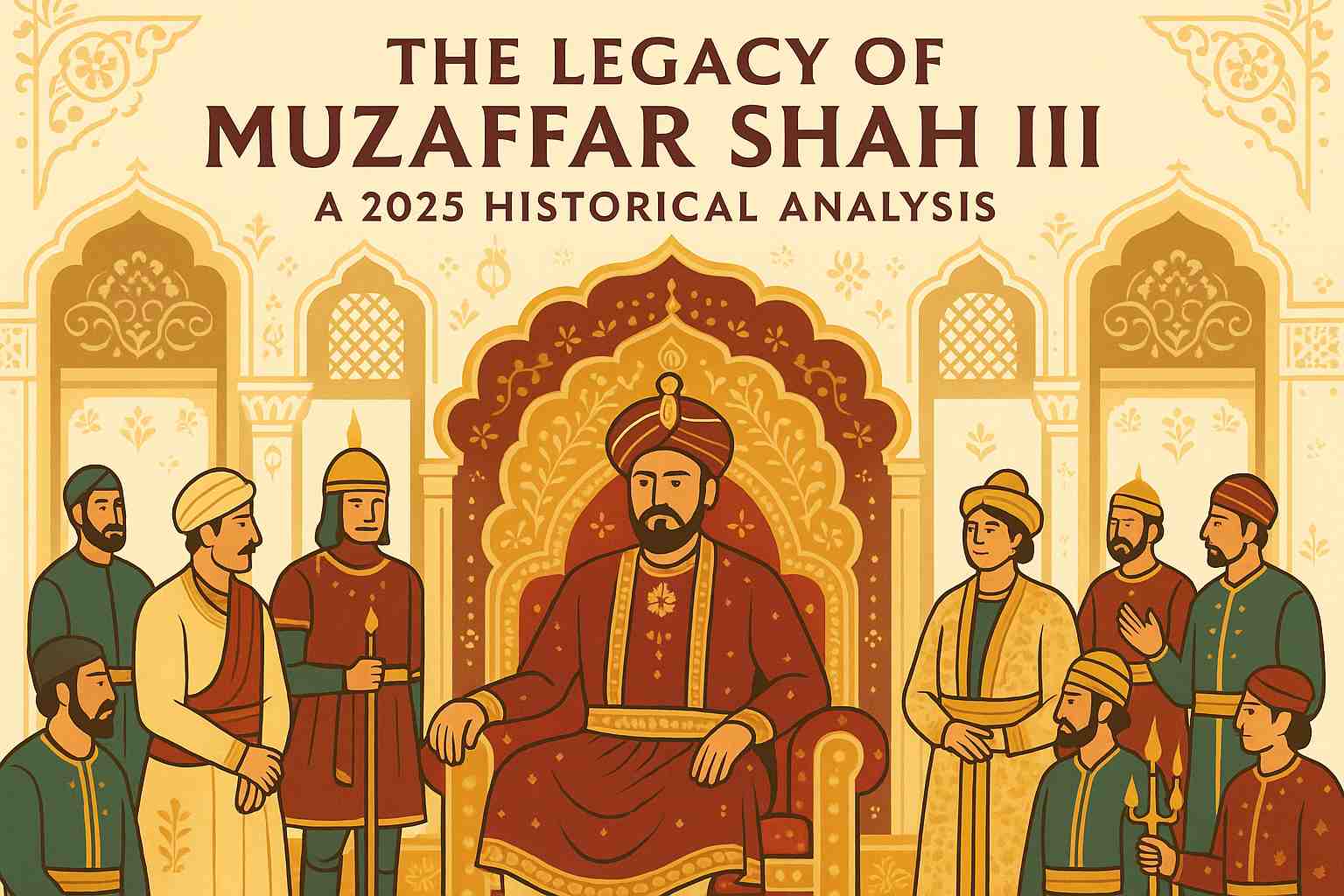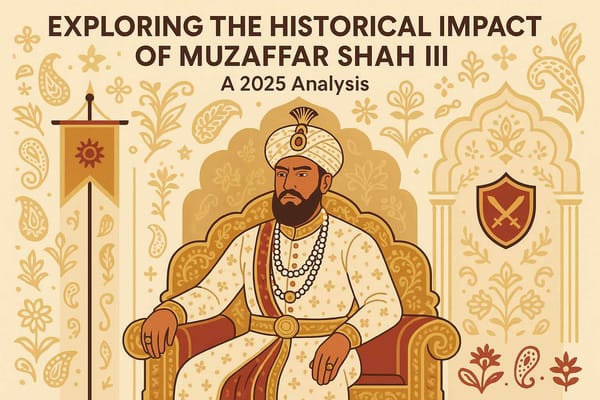
The Legacy of Muzaffar Shah III - A 2025 Historical Analysis
Every corner of our incredible India whispers stories of glory, struggle, and time itself. The soil of Gujarat, especially, holds the memory of a magnificent era – the time of the Gujarat Sultanate. But every story has a final chapter. Today, let’s travel back to the 16th century and walk in the footsteps of a king who stood at the edge of history, Muzaffar Shah III, the last Sultan of Gujarat. His story isn’t just about a kingdom lost; it's a poignant tale of resilience, cultural pride, and a tragic end.
A Crown of Thorns: The Reign of Muzaffar Shah III
So, who exactly was this final ruler of the illustrious Muzaffarid dynasty? Shams Al-Din Muzaffar Shah III ascended the throne in 1561, but it was a throne surrounded by shadows. The air was thick with political tension. From the north, the mighty Mughal Empire under a young and ambitious Emperor Akbar was expanding like a raging fire, and its sights were set on the prosperous lands of Gujarat. Muzaffar Shah III inherited not just a kingdom, but the immense responsibility of protecting its freedom against this formidable force.
His leadership was a constant balancing act. He tried to weave a web of alliances with neighbouring rulers, hoping to create a united front. Inside his kingdom, he focused on what had always been Gujarat’s strength – its trade and economy. Yet, despite his best efforts, the storm was inevitable. His relationship with the Mughal Empire was one of constant resistance, a brave but ultimately challenging struggle to keep his Sultanate's flag flying high.
A Legacy Beyond the Battlefield: Art and Culture in a Tumultuous Time
Even as the clouds of war gathered, Muzaffar Shah III's era was a time when Gujarat's cultural heart beat strongly. A true patron of the arts, he ensured that the kingdom’s soul would not be lost to political strife. The period saw a beautiful fusion of Persian and local Gujarati styles in architecture. Magnificent mosques, imposing forts, and public buildings were commissioned, each telling a story of a rich heritage.
It was this deep love for culture that reminds us of our own mission. At Bhaktilipi, we believe that preserving these stories and timeless traditions is a sacred duty. We strive to bring you the authentic wisdom of our land, presented with the respect and beauty it deserves. If you feel a connection to this rich past, you'll find a home in our space, where devotion meets a deep understanding of our heritage.
The Inevitable Fall: When the Sultanate Crumbled
The might of the Mughals proved too great. In 1573, Emperor Akbar's forces annexed the Gujarat Sultanate. The dream of an independent Gujarat ended, and Muzaffar Shah III was captured and taken as a prisoner to Agra. For many, this would have been the end. But the spirit of the last Sultan was not so easily broken.
In a daring move, he escaped from his prison in 1583 and, with the help of loyal nobles, managed to reclaim his throne for a brief, glorious period. It was a flicker of hope in the darkness. However, this defiance was short-lived. Akbar’s general, Abdul Rahim Khan-i-Khana, defeated him decisively in January 1584. This defeat marked the final, irreversible fall of the Gujarat Sultanate.
A Fugitive King's Tragic End
What followed was a life on the run. Defeated but not dishonoured, Muzaffar Shah III sought refuge with Jam Sataji of Nawanagar State. He lived as a wanderer, a king without a kingdom, forever looking over his shoulder. The final, heartbreaking chapter of his life was written in 1592. Betrayed and surrendered to the Mughals by the ruler of Cutch State, Muzaffar Shah III saw no escape. Rather than face the humiliation of captivity again, he took his own life, a tragic end to a life spent fighting for his homeland.
Why We Remember Muzaffar Shah III Today
Though his reign ended in defeat, the story of Muzaffar Shah III is a vital part of our history. It teaches us about the complex political landscape of 16th-century India, a time when regional powers like the Sultanate of Gujarat and the kingdoms of Rajputana, including the brave state of Mewar, were navigating the rise of the Mughals. Each of these kingdoms has its own epic story of faith and resistance. You can delve deeper into the spiritual legacy of Mewar to understand this interconnected history.
Studying his legacy helps us understand:
- The Transition of Power: His life marks the critical point when Gujarat was absorbed into the vast Mughal Empire, changing its destiny forever. It’s a powerful lesson in how historical tides turn, often with great human cost and stories of incredible bravery.
- Cultural Resilience: Despite the political turmoil, the cultural contributions from his era survived. The art and architecture from the Gujarat Sultanate, including monuments and inscriptions from his time, still stand today, reminding us of the kingdom’s creative spirit. These sites are a must-visit for anyone exploring the sacred tales embedded in our forts and palaces.
Muzaffar Shah III’s story is not just a historical account; it’s a human story of struggle, a fleeting moment of victory, and profound tragedy. It reminds us that our past is filled with figures who, win or lose, have shaped the very fabric of our identity. By remembering them, we honour the journey of our land.
Explore More Knowledge with Bhaktilipi
At Bhaktilipi, our heart lies in preserving these timeless stories from every corner of India. We reimagine them so that they connect with you, today’s reader, and share the authentic wisdom of bhakti with the respect it deserves. We invite you to explore more such historical and spiritual insights on our platform.
To stay connected with our world of devotion and heritage, follow us on YouTube, Instagram, and Facebook. Let's keep these incredible stories alive together!
A passionate group of people dedicated to preserving India's knowledge of Dharma, Karma, and Bhakti for ourselves and the world 🙏.
Comments
Related in

Exploring the Historical Impact of Muzaffar Shah III - A 2025 Analysis
Every kingdom has its final sunset, and for the once-glorious Gujarat Sultanate, that long twilight was embodied by its last ruler, Muzaffar Shah III. His life wasn't just the story of a king; it was a heart-wrenching saga of a collapsing era, a desperate struggle against the inevitable
